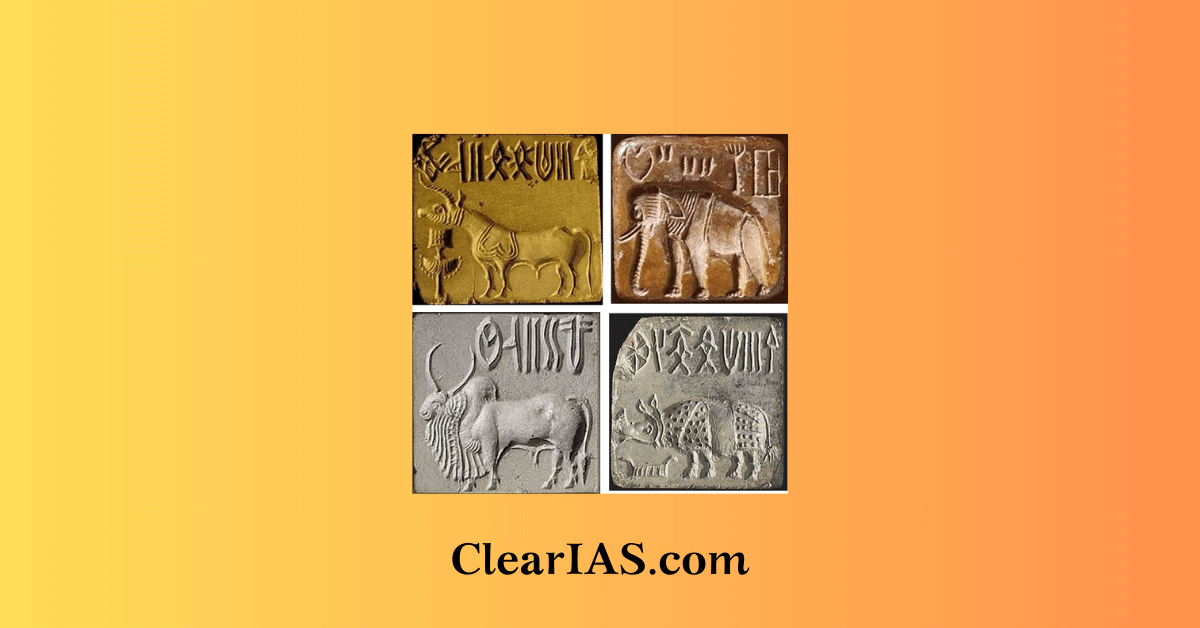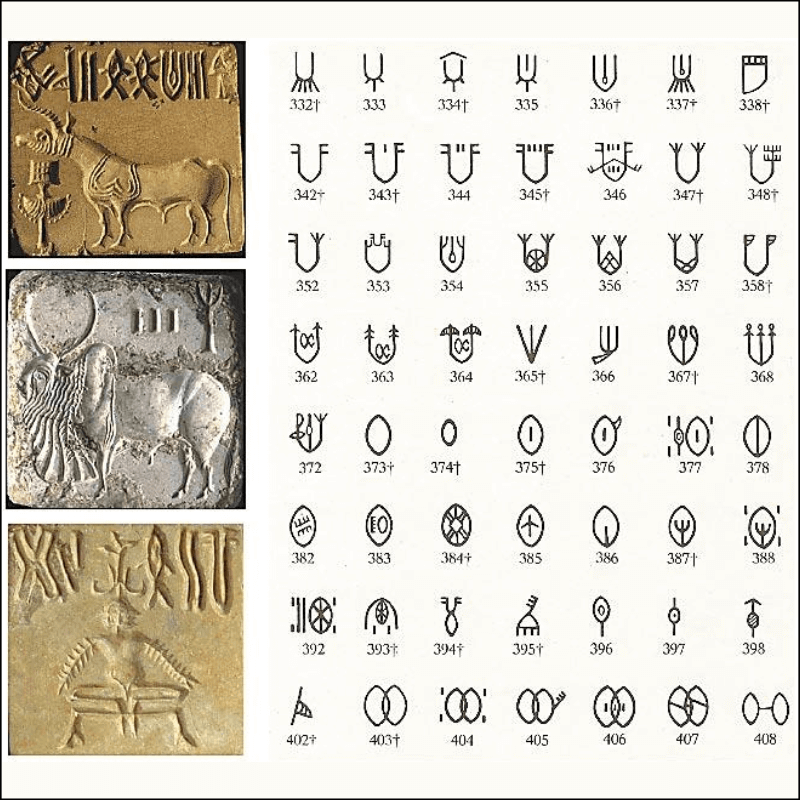
The Indus Valley Script, used by the Indus Valley Civilization (2600–1900 BCE), is one of the oldest writing systems in human history. Despite extensive study, the script remains undeciphered, leaving its purpose and linguistic nature a mystery. Read here to learn more.
Tamil Nadu Chief Minister M.K. Stalin announced a $1-million prize to anyone who deciphers the scripts of the Indus Valley Civilisation.
Has any work in recent times pointed to the possible cultural contact between the Indus Valley and south India?
Notwithstanding the political dimension of the Dravidian concept, historians, archaeologists and linguistic scholars have been debating over the Dravidian hypothesis ever since the publication of Marshall’s article in 1924.
Why is deciphering the Indus script important?
Indus Valley Script
- Discovery: Found in the 1920s during excavations led by Sir John Marshall. It appears on seals, terracotta tablets, pottery, and metal objects.
- Writing Style:
- Primarily written right to left.
- Occasionally employs Boustrophedon Style, alternating directions between lines.
- The brevity of Inscriptions:
- Most inscriptions average 5 characters, with the longest containing 26 symbols.
- This brevity has sparked debate over whether it represents a language or symbolic notations.
- Nature of the Script:
- Believed to be logosyllabic, combining pictograms and syllables.
- It may follow the rebus principle, where symbols indirectly represent sounds or ideas.
Purpose and Function

The exact purpose is unknown, but proposed uses include:
- Trade: Marking goods and maintaining trade records.
- Taxation: Keeping tax-related records.
- Identification: Denoting ownership or lineage.
- Religious or Educational Use: Symbols resembling the swastika or mathematical signs suggest broader cultural significance.
Some scholars argue it was a symbolic marking system rather than a language-based script.
Theories About Its Language
- Dravidian Hypothesis:
- Supported by Asko Parpola and Iravatham Mahadevan.
- Links the script to Dravidian languages, particularly Old Tamil.
- Example: The ‘fish’ symbol may represent “meen,” meaning both “fish” and “star” in Dravidian languages.
- Sanskrit Linkage:
- Early scholars like R. Rao proposed connections to Sanskrit.
- Critics argue the chronological gap between the Harappan and Vedic periods weakens this theory.
- Non-Linguistic Symbols:
- Scholars like Steve Farmer and Peggy Mohan suggest the script consists of non-linguistic symbols used for political, economic, or religious purposes rather than language.
Challenges in Decipherment
Lack of Bilingual Texts
- Absence of Comparatives: Unlike the Rosetta Stone (discovered in 1799 in the Nile Delta), which contained inscriptions in Greek, Demotic, and Egyptian hieroglyphs, the Indus script does not have bilingual texts for cross-referencing.
- This limits the ability to identify symbols, sounds, or their meanings.
Short and Fragmentary Texts
- Brief Inscriptions: Indus texts average about 5 characters, with no long-form narratives.
- Limited data restricts the analysis of grammar, syntax, and recurring patterns that aid linguistic decipherment.
Unknown Language
- No Descendants: The language represented by the script may belong to a lost language family with no surviving modern equivalents.
- Speculations:
- Some theorize it could represent Proto-Dravidian.
- Others suggest an Indo-Aryan or entirely unknown linguistic family.
- The lack of a clear linguistic lineage complicates comparison and interpretation.
Symbol Variations
- Disparities in Estimates:
- S.R. Rao (1982): Proposed 62 signs.
- Asko Parpola (1994): Identified 425 signs.
- Bryan K. Wells (2016): Counted 676 signs.
- Disagreement over the total number and meaning of symbols hinders consensus.
Limited Archaeological Evidence
- Corpus Size: Only about 3,500 Harappan seals and inscriptions have been found.
- Unexplored Sites: Many Harappan sites remain unearthed.
- Artefact Erosion: Time and environmental factors have degraded numerous artefacts, limiting the script’s dataset.
Technological Constraints
- Sparse Data: Modern tools like Artificial Intelligence (AI) and Machine Learning (ML) require large datasets to identify patterns, which the Indus script lacks.
- The complexity of Symbols: Variability in symbols across artefacts adds to the challenge of pattern recognition.
Significance of the Script
Despite remaining undeciphered, the Indus Valley Script:
- Represents an advanced civilization: Demonstrates the complexity of the Indus Valley society.
- Provides clues to trade and culture: Offers insights into their economy, administration, and symbolic systems.
- Holds potential for breakthroughs: Continued research could unlock vital information about one of the world’s earliest urban cultures.
Why is deciphering the Indus Valley script important?
Deciphering the Indus Valley script is crucial for understanding the civilization’s history, culture, and contributions to human development. Here are key reasons why it holds importance:
Understanding an Ancient Civilization
The Indus Valley Civilization (IVC) (2600–1900 BCE) was one of the world’s earliest urban societies. Deciphering its script could:
- Reveal insights into their language, governance, economy, and religion.
- Provide a direct connection to the lives of its people rather than relying solely on archaeological interpretations.
Filling Gaps in South Asian History
- The IVC is foundational to the history of India and South Asia, but the absence of deciphered records creates a gap in historical continuity.
- Deciphering the script could link the IVC to later Vedic, Mauryan, and Dravidian traditions, helping clarify the region’s linguistic and cultural evolution.
Insights into Trade and Economy
- The IVC was a hub of trade, connected to Mesopotamia, Central Asia, and beyond. Deciphering the script could:
- Provide details about trade agreements, weights, measures, and taxation.
- Highlight its contributions to the ancient global economy.
Linguistic and Cultural Understanding
- Decoding the script would offer clues about:
- Whether the language was a precursor to Dravidian, Indo-Aryan, or another linguistic family.
- The belief systems, rituals, and societal values of the civilization.
Unlocking Technological and Scientific Knowledge
- The IVC demonstrated advanced urban planning, metallurgy, and water management. The script might:
- Contain scientific, agricultural, or medical knowledge.
- Showcase innovations that influenced other ancient cultures.
Advancing Epigraphic Studies
- Successful decipherment could set a precedent for interpreting other undeciphered scripts worldwide, such as the Rongorongo script of Easter Island.
Way forward
Despite these challenges, efforts continue to decipher the Indus script using:
- Interdisciplinary Approaches: Combining linguistics, archaeology, and computational methods.
- Advanced AI Models: Improved algorithms to analyze brief texts and identify symbolic patterns.
- Collaborative Research: International cooperation to expand datasets and explore new methodologies.
Conclusion
Deciphering the Indus script could elevate the IVC’s role in world history, highlighting its contributions to global heritage. It would deepen our understanding of the interconnectedness of ancient civilizations and enrich our collective human story.
Frequently Asked Questions (FAQs)
Q. Why is the Indus Valley script still difficult to understand?
Ans: So far, the Indus writing system could not be translated because the texts are too short, we have no bilingual inscription and we do not which language or languages were transcribed. Moreover, it is possible that it worked differently from any other writing system of the same general period.
Q. What ancient language has been decoded by AI?
Ans: The field of archaeology has been revolutionized by the use of artificial intelligence (AI) in decoding ancient tablets. AI-powered translation programs have been developed to decipher ancient texts, such as the 5,000-year-old Akkadian cuneiform, enabling researchers to unlock the secrets of the past.
Related articles:
- Arts of Indus Valley Civilization
- Important Indus Valley Sites and the archaeological discoveries
- Ancient civilizations of the world
-Article by Swathi Satish





Many thanks Swasthi …..